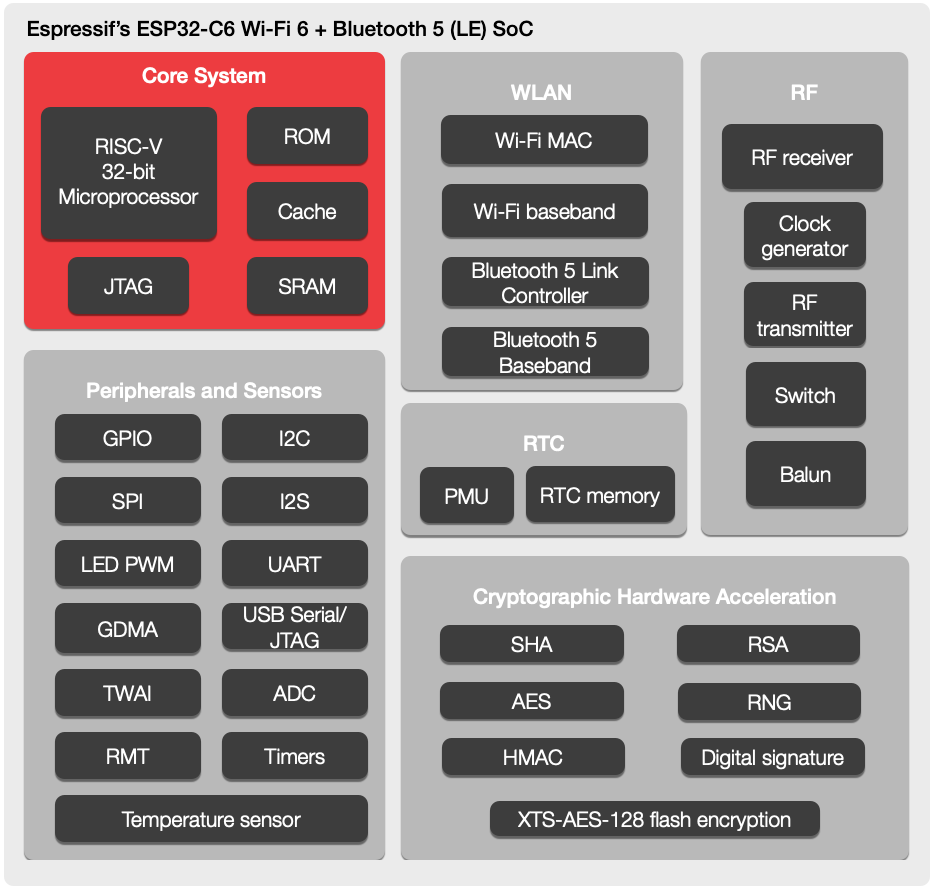- Home
- Hardware
- SDKs
- Cloud
- Solutions
- Support
- Ecosystem
- Company
- Contact
news
Announcing ESP32-C6: a Wi-Fi 6 + Bluetooth 5 (LE) SoC
Shanghai, China
Apr 9, 2021
ESP32-C6 is Espressif’s first low-power and cost-effective Wi-Fi 6 + Bluetooth 5 (LE) SoC, with a 32-bit RISC-V core, for securely connected devices. ESP32-C6 is already certified by the Wi-Fi Alliance.
On April 9th, 2021, Espressif Systems (Shanghai) Co., Ltd. (SSE: 688018.SH) announced the upcoming release of ESP32-C6, a new Wi-Fi 6 + Bluetooth 5 (LE) SoC. After successfully launching ESP32-C3, with Wi-Fi 4 and Bluetooth 5 (LE) capabilities, towards the end of 2020, we are proud to be taking our SoC offering to the next level with ESP32-C6, which adds Wi-Fi 6 capabilities to our product portfolio. ESP32-C6 has already been certified by the Wi-Fi Alliance.
ESP32-C6 is unique in that it packs 2.4 GHz Wi-Fi 6 (802.11ax) radio that also supports the 802.11b/g/n standard for backward compatibility. This Wi-Fi 6 support is optimized for IoT devices, and the SoC supports a 20MHz bandwidth for 802.11ax mode, and a 20/40MHz bandwidth for 802.11b/g/n mode. The 802.11ax mode supports a station interface, and it offers greater transmission efficiency and lower power consumption. Additionally, Bluetooth 5 (LE) radio supports long-range operation through advertisement extension and coded PHY. It also supports 2 Mbps of high throughput PHY.
In terms of CPU, memory and security features, ESP32-C6 is similar to ESP32-C3. ESP32-C6 has a single-core, 32-bit RISC-V microcontroller that can be clocked up to 160 MHz. It has a 384KB ROM, a 400KB SRAM, and works with external flash. It comes with 22 programmable GPIOs, with support for ADC, SPI, UART, I2C, I2S, RMT, TWAI and PWM.

ESP32-C6 Block Diagram
However, the 802.11ax standard used in ESP32-C6 contains a variety of extra features added to the current Wi-Fi standard, and we have carefully chosen those features that provide concrete benefits for IoT devices. ESP32-C6 supports the OFDMA (Orthogonal Frequency Division Multiple Access) mechanism for both uplink and downlink communications. It also supports MU-MIMO capability for downlink. Both of these techniques provide the ability to work with high efficiency and low latency in congested wireless environments. One more important feature of the 802.11ax standard is the Target Wake Time (TWT), which allows the devices to sleep for an extended time-period, with assistance from an 802.11ax-capable, Wi-Fi access point. This feature in ESP32-C6 will allow our customers to build battery-operated, connected devices that can last for years on battery, while staying connected throughout.
Espressif continues to safeguard the security of connected devices through hardware and software features. ESP32-C6 comes with RSA-3072-based secure boot, AES-128-XTS-based flash encryption, digital signature and an HMAC peripheral for identity protection, as well as cryptographic accelerators for improved performance. These features ensure that the devices built with ESP32-C6 can provide the desired level of security.
ESP32-C6 will be supported through Espressif’s mature IoT Development Framework (ESP-IDF), so that our customers can benefit from their familiarity with the our field-proven platform that already powers millions of connected devices. For the customers who would like to use ESP32-C6 as a communications co-processor with an external host, ESP-Hosted and ESP-AT firmware will also be available.
If you are interested in ESP32-C6, please contact our customer support team. We will get back to you as soon as possible.


 LinkedIn
LinkedIn 微信
微信
 Twitter
Twitter Facebook
Facebook
